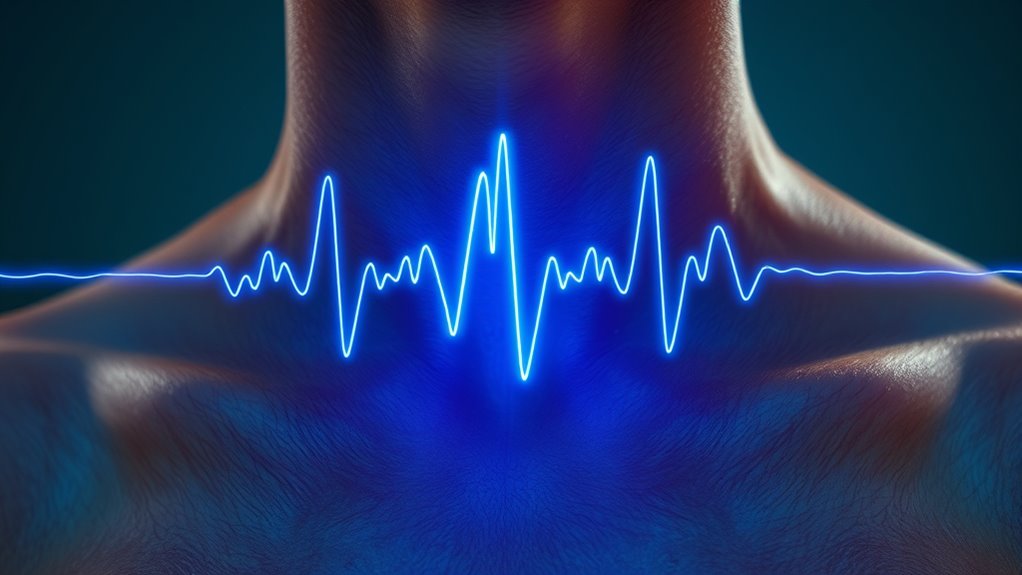Breath considerably influences your heart-rate variability (HRV), which reflects your nervous system’s flexibility and resilience. Slow, deep breathing activates your parasympathetic system, promoting relaxation and heart rhythm balance, while rapid breathing triggers stress responses. By practicing controlled breathing techniques like coherent or diaphragmatic breath, you can improve HRV and overall health. Exploring these connections further reveals how breath work can optimize your stress response and well-being.
Key Takeaways
- Breath patterns directly influence HRV by activating the autonomic nervous system’s sympathetic or parasympathetic pathways.
- Slow, deep breathing enhances parasympathetic activity, increasing HRV and promoting relaxation.
- Heart and breath rhythms are synchronized through the vagus nerve, linking breathing control to heart rate regulation.
- Techniques like coherent breathing optimize HRV by maintaining consistent inhale/exhale cycles.
- Monitoring HRV provides insights into autonomic balance, stress levels, and overall health, reflecting the impact of breathing practices.
Understanding Heart-Rate Variability and Its Significance

Understanding heart-rate variability (HRV) is essential because it reflects how well your autonomic nervous system regulates your heart’s function. HRV measures the fluctuations in your heartbeat intervals, revealing your body’s ability to adapt to stress and changes. Higher HRV indicates your nervous system is flexible, efficiently balancing sympathetic and parasympathetic responses, which supports overall health. Conversely, low HRV suggests less adaptability, often associated with stress, fatigue, or health issues. By monitoring HRV, you gain insight into your physiological resilience and stress levels. This understanding empowers you to make informed lifestyle choices that promote better health and well-being. Additionally, practicing mindfulness and breathing exercises can help improve HRV by reducing stress and enhancing autonomic function. Research in AI in Education suggests that incorporating biofeedback and personalized health monitoring tools can further support individuals in managing their HRV effectively. Maintaining a healthy nervous system is crucial for optimal HRV, as it directly influences your body’s ability to respond to various stimuli. Ultimately, HRV serves as a window into your body’s internal balance, helping you optimize your physical and mental performance.
The Role of the Autonomic Nervous System in Regulating Heart and Breath

The autonomic nervous system (ANS) plays a crucial role in regulating your heart and breath without your conscious effort. It manages your body’s involuntary functions, balancing stress and relaxation. The ANS has two main parts: the sympathetic and parasympathetic divisions. The sympathetic activates your fight-or-flight response, increasing heart rate and breathing. The parasympathetic promotes rest and recovery, slowing these functions down. Understanding sound healing science can provide insights into how specific frequencies influence these autonomic responses. Additionally, various essential oils have been shown to influence the ANS by promoting relaxation or alertness, thereby affecting heart and respiratory functions. Recent research also highlights the role of biofeedback techniques in training individuals to better regulate their autonomic responses, which can be beneficial for stress management and health. Techniques such as mindfulness and meditation can further enhance autonomic regulation, leading to improved overall well-being.
How Breathing Patterns Influence Heart Rhythms

Your breathing patterns have a direct and powerful impact on your heart rhythms. When you breathe slowly and deeply, you activate your parasympathetic nervous system, promoting relaxation and a steady heart rate. Rapid or irregular breathing, on the other hand, stimulates your sympathetic nervous system, leading to increased heart rate variability and potential stress responses. The rhythm of your breath influences the timing of heartbeats through the vagus nerve, which links your breath to your heart’s electrical activity. By consciously adjusting your breathing, you can synchronize your heart rhythms, fostering calmness and balance. This connection shows how your breath doesn’t just supply oxygen—it actively shapes your cardiovascular health and emotional state. Understanding this influence empowers you to harness your breath for better heart rhythm regulation through mindfulness, and incorporating breathing techniques can enhance this effect further. Additionally, choosing a dog name that resonates with your personality can offer emotional support during relaxation practices.
Techniques to Modulate Heart-Rate Variability Through Breath Control

Practicing specific breathing techniques allows you to effectively modulate heart-rate variability and enhance your overall cardiovascular health. One effective method is slow, diaphragmatic breathing, where you breathe deeply through your nose at a rate of about 5 to 6 breaths per minute. This stimulates the parasympathetic nervous system, promoting relaxation and increasing HRV. Another technique is coherent breathing, which involves maintaining a consistent inhale and exhale duration, such as a 4-6 second cycle. You can also incorporate breath-holding or pause techniques, like pause after exhalation, to further influence your heart rhythms. Regular practice of these methods encourages your heart to adapt more flexibly to stress and recovery, ultimately supporting a balanced autonomic nervous system and improving overall cardiovascular resilience. Environmental interactions play a crucial role in shaping your body’s ability to respond to stress and maintain heart health. Additionally, understanding the impact of heart-rate variability on overall well-being can motivate consistent practice of these techniques. Incorporating awareness of your autonomic nervous system responses during practice can further optimize your results.
Implications for Health, Stress Reduction, and Disease Detection

Understanding and monitoring heart-rate variability (HRV) offers valuable insights into your overall health and stress levels. Higher HRV generally indicates better resilience and adaptive capacity, while lower HRV can signal stress, fatigue, or potential health issues. By tracking HRV, you can identify early signs of illness or imbalance, enabling proactive interventions. HRV is also useful for managing stress, as breathing techniques and relaxation strategies can improve it. Breathing techniques and relaxation strategies are particularly effective in enhancing HRV and promoting mental well-being. In clinical settings, HRV analysis helps detect cardiovascular problems and autonomic nervous system dysfunction. Regularly evaluating HRV empowers you to make informed lifestyle choices, optimize recovery, and maintain mental clarity. Essentially, paying attention to HRV opens a window into your body’s internal state, supporting both prevention and wellness. Additionally, advancements in heart-rate variability research continue to deepen our understanding of its role in overall health and disease detection. Incorporating mindfulness practices can also positively influence HRV by reducing stress and supporting autonomic balance. Moreover, autonomic nervous system function plays a crucial role in how HRV reflects your body’s response to various stimuli and health conditions.
Frequently Asked Questions
Can Specific Breathing Exercises Improve Long-Term Heart Health?
Yes, specific breathing exercises can boost your long-term heart health. By practicing techniques like slow, deep breathing or diaphragmatic breathing regularly, you help lower your blood pressure, reduce stress, and improve your heart’s resilience. These exercises encourage your nervous system to balance itself, leading to better heart rate variability. Over time, consistency in breathing exercises supports healthier cardiovascular function and can decrease your risk of heart disease.
How Does Emotional State Directly Affect Heart-Rate Variability?
Your emotional state directly impacts your heart-rate variability (HRV). When you’re calm and relaxed, HRV tends to increase, indicating better heart health. On the other hand, stress, anxiety, or anger lower HRV, showing your body’s fight-or-flight response is active. You can improve your HRV by managing emotions through mindfulness or relaxation techniques, which help you stay calmer and promote a healthier heart over time.
Are There Genetic Factors Influencing Individual HRV Responses?
You might wonder if genetics influence how your heart-rate variability (HRV) responds. Yes, your genetic makeup can play a role, affecting factors like autonomic nervous system regulation and stress responses. These genetic factors can cause differences in HRV patterns among individuals. While lifestyle and environment are vital, your genes set a baseline that influences how your HRV reacts to various emotional and physical stimuli.
What Technological Advancements Are Used to Monitor HRV in Real-Time?
You can now monitor HRV in real-time using advanced wearable devices like smartwatches and chest straps, which are equipped with sensors to track your heart’s rhythm continuously. These devices analyze your heartbeat patterns and provide instant feedback via apps, helping you manage stress, optimize training, or improve overall health. Innovations in sensor technology and data processing have made real-time HRV monitoring more accurate, accessible, and user-friendly.
How Does Age Impact the Relationship Between Breath and Heart Rhythms?
Age influences how your breath and heart rhythms connect. As you get older, your heart’s ability to adapt and respond to breathing patterns may decline, making the relationship less prominent or more irregular. Younger individuals typically show a stronger synchronization between breath and heart rate, while aging can weaken this link. Understanding these changes helps you tailor breathing exercises or interventions to maintain heart health throughout your life.
Conclusion
By mastering breath control, you can significantly boost your heart-rate variability, which is linked to better health and stress resilience. Notably, studies show that athletes with higher HRV are 50% more resilient to stress and recover faster. So, by simply paying attention to your breathing, you tap into a powerful tool that supports your overall well-being, helps manage stress, and even aids in early disease detection. Start breathing consciously today—it’s a small step with big health benefits.










